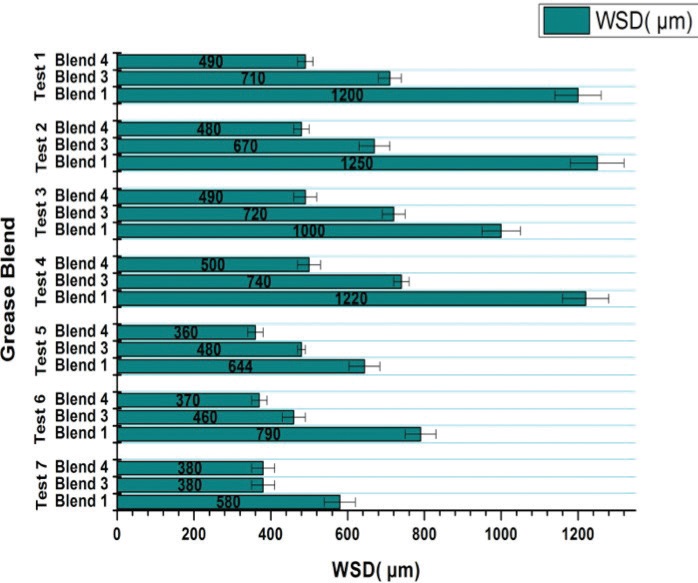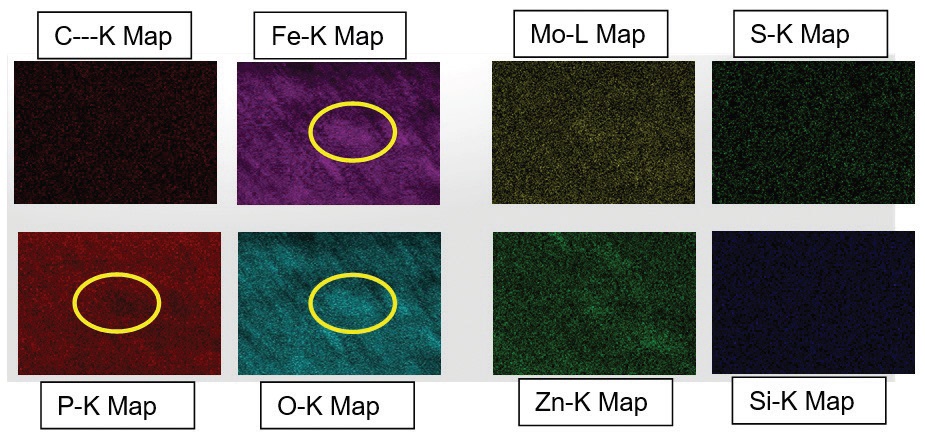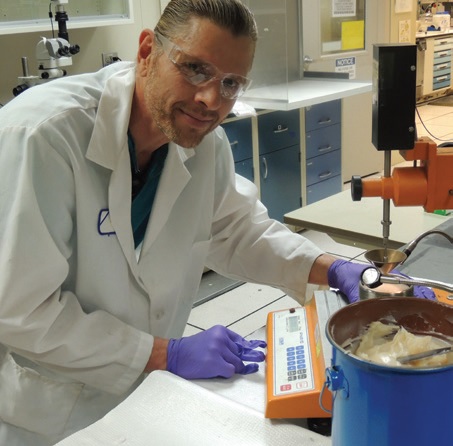TLT: Why would the aviation industry be interested in advanced grease lubricants?
Mordaunt: Great question—one does not exactly hear the aviation industry clamoring for improved grease lubrication all that often, and, once a grease is found to perform well in its application, we naturally move on, almost taking it for granted.
When there is a failure, though, many eyes can come upon an issue suddenly, which can catalyze grease-development projects. This particular grease project may be unusual in the sense that there was no failure; in fact, the greases out there being used on our airplanes seem to perform well. But several years ago, some of our bearing experts identified and patented an interesting lubrication system comprised of a specific grease and a specific metal alloy, which, when combined in a moving joint, produced extraordinarily improved wear and friction performance.
In an effort to advance lubrication technology and bring this performance and other advantages to the industry as a standard, we are attempting to develop a new general-purpose grease based on the patented technology. The aviation industry is interested in advanced grease because:
a.
It can reduce the number of greases used on the plane. If qualified successfully, one general-purpose grease that works in both airframe and landing gear applications would reduce confusion over which grease goes where (a safety concern), in addition to simplifying inventory and cost management. Now Boeing uses general-purpose grease that addresses about 90% of the plane’s joints, while landing gear grease addresses another 9%, and the remaining 1% address specialty applications like electrical and so forth. We aim to address about 99% of the plane with the new advanced grease.
b.
It can improve performance. A new grease that significantly improves wear and friction potentially translates into extended maintenance intervals, reduced grease refill frequency and extended component life—all of which can reduce operating cost while enabling more revenue-generating flights for airline operators.
Using new and existing lubrication technology, we are pushing hard to reduce wear while at least maintaining friction performance. Tests such as four-ball wear (
see Figure 1), which we worked with a university to optimize, can tell much in the way of certain additive performance and serves as a good screening method. Once four-ball screened, we move to more sophisticated testing that involves the grease and the specific alloys of interest and new instrumentation such as SRV (Schwingung Reibung Verschlei, German for reciprocating friction and wear), mini-traction-machine and others.
 Figure 1. Four-ball wear grease tests showing wear scar diameter (WSD) results for various formulations. (Figure courtesy of The Boeing Co. and the University of Texas at Arlington.)
Figure 1. Four-ball wear grease tests showing wear scar diameter (WSD) results for various formulations. (Figure courtesy of The Boeing Co. and the University of Texas at Arlington.)
c.
It can enable weight reduction. Particularly in applications where friction and heat are an issue, it is common for more structure (metal) to be added to the joint components as a heat sink and to counter fatigue caused by high contact stresses and temperatures. A high-performance grease that lowers friction and wear, thereby lowering temperatures, could lead to lighter-weight joints in new airplane designs. Aircraft weight directly affects the economics of flight, and any weight saved on an airplane is a significant cost saving for airline customers. Weight savings for commercial aircraft also has many performance customer benefits such as efficiency, payload and range. Taking multiple pounds off a plane and implementing across an airline’s fleet is profit going directly to the bottom line. Who would have guessed that grease could help reduce aircraft weight?
TLT: What are the major challenges in qualifying a new lubricant for aerospace application?
Mordaunt: Qualification projects are almost always lengthy and costly due to the difficult requirements that materials must meet in order to fly on an airplane. Suffice to say, building jet airplanes is extremely difficult, and getting a new material qualified as flightworthy is an extraordinary challenge that can take years. For example, grease must perform at altitudes where temperatures approach -100 F and remain stable at temperatures as high as 350 F in extreme-pressure applications such as landing gear. Keeping temperatures low in all joints is an important key to extending component life and meeting the overall objective of advanced grease development.
Formulation, reformulation, test methods, technology, expertise and raw material cost and availability are some of the major points to consider before embarking on this sort of development. We think this is an appropriate time to advance grease technology as these factors seem to have available, although difficult, pathways forward. I elaborate in several areas below.
a.
Formulation. More grease additives are available today, which gives formulators more options to explore when creating a new product. Formulators have the tricky task of balancing additives into a viscous carrier matrix while meeting a plethora of performance requirements. Competition for reaction sites on the wearing surfaces means that gains in one performance property are often made at the sacrifice of another. For example, extreme-pressure performance may be met but at the expense of corrosion protection depending on the affinity the additive has for the surface. Adding one component detracts another. The challenge is getting enough high-performance additives delivered to the friction boundary to be effective, but it’s like any situation that gets too crowded. Something has to give, and often reformulation or resequencing additive treatment is required in order to find the sweet spot.
b.
Test methods. Our grease specifications document dozens of test requirements that together do a good job of simulating airplane flight cycle conditions. Some tests are rigorous and expensive, and we run additional proprietary testing in house to make sure we get the full picture of performance expectations. The objective is to reduce the risk of failure and unknowns in service as much as we can. Because of the proprietary and expensive nature of some tests, we partnered with suppliers to develop less daunting, more accurate screening tests to predict performance in these tests so that suppliers interested in developing new greases can have test methods at their fingertips to screen promising grease formulations. In particular, we are involved in developing new SRV methods and using the relatively new mini-traction-machine technology.
Grease has to perform at -100 F and as high as 350 F, which makes formulation the utmost challenge. Some peak temps in landing gear can approach 800 F. Keeping temperatures stable and low is key to leveraging improved wear and friction performance.
c.
Expertise. Developing a high-performance grease requires expertise in tribology, surface analysis, testing, lubrication chemistry and metal alloys, as well as administrative experts in intellectual property, financing and project management. Fortunately, Boeing employs experts in some of these areas, and we’re thankful suppliers are able to fill gaps and do most of the hands-on work, without which this project would be impossible. We also work with very capable experts and students at universities to help identify and test new additive chemistry and provide surface analysis of tribological films like that shown in Figure 2, where EDX analysis is used to see what elements are present on the surface. In the end, any new lubricant must be marketable and meet the cost constraints thereof, but there also must be a good business reason to invest in such a development in the first place, and this project is one such example where the business case is a little more obscure. Ultimately, advanced grease can directly benefit airline customers by lowering operating costs.
 Figure 2. Energy-dispersive X-ray spectroscopy (EDX) of four-ball wear scars checking elemental presence. (Figure courtesy of The Boeing Co. and the University of Texas at Arlington.)
Figure 2. Energy-dispersive X-ray spectroscopy (EDX) of four-ball wear scars checking elemental presence. (Figure courtesy of The Boeing Co. and the University of Texas at Arlington.)
One unique approach we are taking in this advanced grease project is to develop a lubrication system, not just a lubricant. As a system, we account for and test the metal alloy used on the airplane along with the grease. Some development efforts in the past approached the grease separately from the metal without consideration of chemical reactions with elements in the bearing alloy. It is possible to create and optimize unique tribofilms by using specific grease additives that react with specific metal alloy components, thereby creating tough, protective tribofilms on wearing surfaces. Another approach we are taking is prioritizing wear performance over friction performance. Friction may not necessarily be improved significantly with our new grease, but the tribofilms created can protect the joint and reduce wear significantly, thereby extending component life. The best of both worlds would, of course, be to create a low-wear and low-friction lubricant, which is what we are aiming for—but getting there remains to be seen.
 Kane Mordaunt performing grease penetration testing. (Photo courtesy of The Boeing Co.)
TLT: How does someone go about working with an aerospace OEM on lubricants?
Mordaunt:
Kane Mordaunt performing grease penetration testing. (Photo courtesy of The Boeing Co.)
TLT: How does someone go about working with an aerospace OEM on lubricants?
Mordaunt: Typically, Boeing reaches out to suppliers for these sorts of projects, but sometimes a supplier may approach Boeing or at least plant the seed for a project. Kicking off a technical development project such as advanced grease can be and is challenging right out of the gate. First, both the OEM and supplier have the issue of identifying appropriate contacts, capability and experts and convincing each other that the endeavor is worthwhile. Establishing an effective team that is willing and able to actively participate is worth the investment as it is tantamount to success.
Then comes issues of intellectual property and ownership, which invokes time-consuming legal reviews and consults. Nothing can happen until the contractual foundation is defined, and if two large companies with long timelines are involved, waiting too long can kill the project as funding has a finite shelf life. Frankly, the front end of a project is the most challenging as team building, contract terms and conditions and information agreements can consume upward of one to two years before completion. But once the statement of work is agreed, and all the i’s are dotted, it’s off to the lab for the supplier while the OEM seeks to manage the project and arrive at the prototype phase in a timely manner.
Boeing has an extensive specification system in which most requirements are documented, so sharing these requirements up front is another important aspect of success. At some point, the supplier will have a product to evaluate, and that is where we take additional steps to validate certain critical performance and material characteristics against the specifications. When all the requirements are satisfied, we will award the supplier with a formal qualification to that specification.
TLT: What are you most proud of in your job as subject matter expert on lubrication for a major aerospace company?
Mordaunt: Learning! I have learned much about legal contracts, intellectual property and university, supplier and Boeing capabilities. The expertise that universities, Boeing and suppliers bring to the table is very humbling and impressive. I have fantastic colleagues helping with this project, and working with them has made my job much easier and less stressful. I don’t have all the answers, but with one communication I can often get the answer. Finding the right experts can be a challenge, but once onboard they keep the ship sailing straight. Same goes for suppliers who develop grease. They employ their own flavor of experts in testing, formulation and processing, and together we complement each other perfectly. My hope is that I have the opportunity to manage an innovation similar to this in the future because next time I will be able to do it much more efficiently.
You can reach Kane Mordaunt at kane.mordaunt@boeing.com.